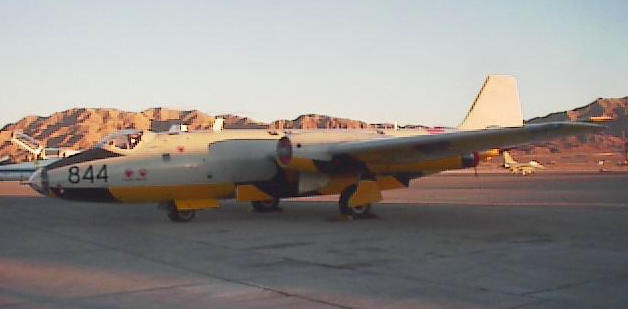|

Tom Foscue's TT.18 Canberra, WJ574 (N77844), at
Nellis AFB, February, 1999.
History: The RAF's first bomber, the
Canberra, served on the frontlines for 57 years after it was first flown.
Chief designer W. Petter had just joined the design team at English Electric when work
began on the Canberra. He changed the swept wings of the original design to a more
unconventional design with the engines part way out on, and embedded in, the wing. The end
sections of the wings were broad and square, and two powerful Rolls-Royce Avon engines
completed the design. The crew of two sat side-by-side in a pressurized cabin. With good
fuel economy, and excellent maneuverability at all altitudes, the EE.A1
was an instant success.
The prototype was first flown on May 13, 1949, and was
problem-free. The first four prototypes were designated the Canberra B.MK 1,
and were intended for use with a radar-assisted bomb aiming system. A delay in this system
led to the production of a day bomber prototype, the Canberra B.MK 2,
and the first operational aircraft were delivered on May 25, 1951. The Canberra B.MK 2
differed in having a crew of three, the added member being the bombardier. The Canberra
carried no defensive armament, placing its safety in speed and altitude. Indeed, for many
years, the Canberra flew higher than any other aircraft, and in 1957 it captured a world
altitude record of 70,000 feet. Well liked around the world, the U.S. Air Force even built
the Canberra as the Martin B-57 to replace its B-26 medium
bombers. The B-57 saw combat over Vietnam alongside other Canberras from Australia. In
its final
years, the Canberra was mostly relegated to photographic reconnaissance (PR.Mk
9) and electronic warfare duties. A total of 1,352 Canberras were built
before production ceased.
Today, approximately ten privately-owned Canberras can be found, several of which are actively
airworthy. In
addition, with the 2006 retirement of the type in the UK, Canberra
fuselage sections have been auctioned off to collectors worldwide.
Nicknames: Cranberry; Caterpillar
(Derogatory name given to USAF B-57s by Vietcong);
Marrow.
Specifications (PR.Mk 9):
Engines: Two 11,000-pound thrust Rolls-Royce Avon 206 turbojets
Weight: Max Takeoff 54,950 lbs.
Wing Span: 67ft. 10in.
Length: 66ft. 8in.
Height: 15ft. 8in.
Performance:
Maximum Speed at
40,000 ft: 541 mph
Ceiling: 48,000
ft.
Range: 3,630
miles
Armament: None (Bomber versions carried
up to 8,000 pounds of bombs -- 6,000 internally / 2,000 externally)
Number Built: 1,352
Number Still Airworthy: At least
3.
Links:
Canberra Association
Canberra Tribute Site
Canberra
TT.18 at Temora Aviation Museum, Australia.
CNAPG Canberra Page
FRADU Canberras
HAMM, Inc.
(High Altitude Mapping Missions)
"Rolling
Thunder" Classic Jets Page

[Back to Warbird Alley's Main
Page]
All text and photos
Copyright 2016 The
Doublestar Group, unless otherwise noted.
You may use this page for your own, non-commercial reference purposes only.
 |